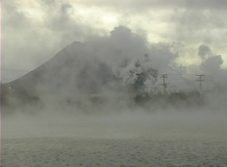Uncle Tasman - The Trembling Current that Scars the Earth (2008)
3-channel video installation with sound. 11:11 minutes. (Sound commmences at 00.30 sec)

Natalie Robertson’s Uncle Tasman: The Trembling Current that Scars the Earth is a three-screen video installation recorded at geothermal sites in the Eastern Bay of Plenty. Robertson draws on customary and contemporary mythologies of land and place to examine paradoxes of economic development and environmental destruction.
In pre-colonial times, the area was densely populated with people attracted to the natural geothermal springs. As newcomers from overseas arrived they were also attracted to the geothermal steam, establishing a paper mill in Kawerau, known locally as Uncle Tasman. In 1954 New Zealand government passed an act that allowed effluent from the mill to be discharged into the Tarawera River. The accumulated discharge has formed what Greenpeace calls the most serious toxic waste dump in New Zealand. Kawerau is Robertson’s hometown and has the highest age-standardised cancer registration rate of all health Territorial Authorities in New Zealand.
Robertson recorded local stories of the desecration of sites of significance that are contrasted with the scenographic beauty of the locations. Loss and grief emerge in the local tribal story of the love triangle of volcanic mountains Putauaki, Tarawera and Whakaari and it is the story of a clean, green New Zealand that comes under question as a geothermal lake smothered by waste, Rotoitipaku, is recalled by people who lived nearby.
A tauparapara, a chant by Te Haukakawa Te Rire, speaks of Ngati Tuwharetoa ki Kawerau tribal histories and cosmology. A local man recalls memories of Lake Rotoitipaku and tells of eels dying, unable to live in the toxic water. The customary Ngati Porou haka Ka Panapana, is performed to call for social justice and is followed by a haka, Ruaumoko, who is God of earthquakes and volcanoes, – and Papatuanuku’s (Earth Mother) unborn child, stirring and kicking, eager to live up to the promise of its name signifying an earthquake scar, a reminder that Aotearoa sits balanced along the Pacific “rim of fire” with potential for sludge from deeply toxic dumping sites to be scattered far and wide from what is known as the Taupo volcanic plateau if eruptions were to occur from that site.